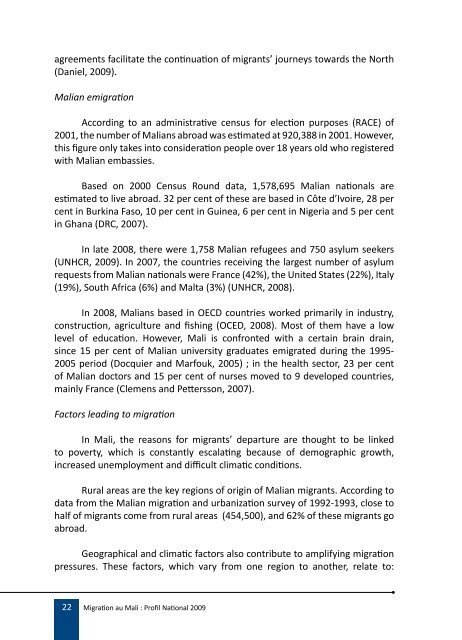Migration au Mali : Profil National 2009 - IOM Publications
Migration au Mali : Profil National 2009 - IOM Publications
Migration au Mali : Profil National 2009 - IOM Publications
You also want an ePaper? Increase the reach of your titles
YUMPU automatically turns print PDFs into web optimized ePapers that Google loves.
agreements facilitate the continuation of migrants’ journeys towards the North<br />
(Daniel, <strong>2009</strong>).<br />
<strong>Mali</strong>an emigration<br />
According to an administrative census for election purposes (RACE) of<br />
2001, the number of <strong>Mali</strong>ans abroad was estimated at 920,388 in 2001. However,<br />
this figure only takes into consideration people over 18 years old who registered<br />
with <strong>Mali</strong>an embassies.<br />
Based on 2000 Census Round data, 1,578,695 <strong>Mali</strong>an nationals are<br />
estimated to live abroad. 32 per cent of these are based in Côte d’Ivoire, 28 per<br />
cent in Burkina Faso, 10 per cent in Guinea, 6 per cent in Nigeria and 5 per cent<br />
in Ghana (DRC, 2007).<br />
In late 2008, there were 1,758 <strong>Mali</strong>an refugees and 750 asylum seekers<br />
(UNHCR, <strong>2009</strong>). In 2007, the countries receiving the largest number of asylum<br />
requests from <strong>Mali</strong>an nationals were France (42%), the United States (22%), Italy<br />
(19%), South Africa (6%) and Malta (3%) (UNHCR, 2008).<br />
In 2008, <strong>Mali</strong>ans based in OECD countries worked primarily in industry,<br />
construction, agriculture and fishing (OCED, 2008). Most of them have a low<br />
level of education. However, <strong>Mali</strong> is confronted with a certain brain drain,<br />
since 15 per cent of <strong>Mali</strong>an university graduates emigrated during the 1995-<br />
2005 period (Docquier and Marfouk, 2005) ; in the health sector, 23 per cent<br />
of <strong>Mali</strong>an doctors and 15 per cent of nurses moved to 9 developed countries,<br />
mainly France (Clemens and Pettersson, 2007).<br />
Factors leading to migration<br />
In <strong>Mali</strong>, the reasons for migrants’ departure are thought to be linked<br />
to poverty, which is constantly escalating bec<strong>au</strong>se of demographic growth,<br />
increased unemployment and difficult climatic conditions.<br />
Rural areas are the key regions of origin of <strong>Mali</strong>an migrants. According to<br />
data from the <strong>Mali</strong>an migration and urbanization survey of 1992-1993, close to<br />
half of migrants come from rural areas (454,500), and 62% of these migrants go<br />
abroad.<br />
Geographical and climatic factors also contribute to amplifying migration<br />
pressures. These factors, which vary from one region to another, relate to:<br />
22 <strong>Migration</strong> <strong>au</strong> <strong>Mali</strong> : <strong>Profil</strong> <strong>National</strong> <strong>2009</strong>
















